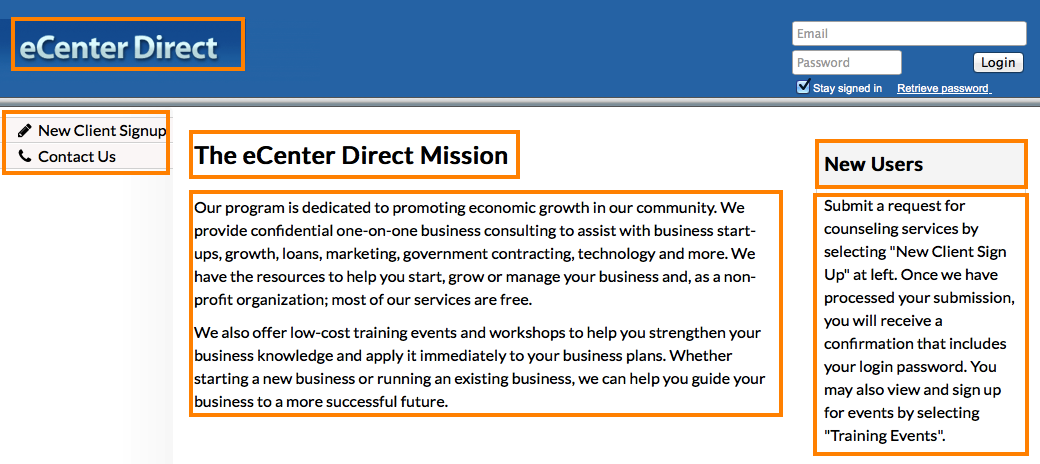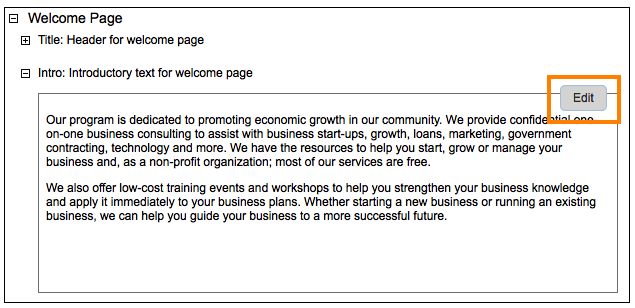How do I customize the text on eCenter Direct?
Although OutreachSystems provides out-of-the-box text throughout eCenter Direct, almost all of this default text can be (and probably should be) customized to reflect your program's unique operations. A prime example of this is eCenter's main welcome page; as shown in the next graphic, most of the text on this page can be customized (represented by the orange highlights).

eCenter interface customization is performed from within Neoserra, from one (or both) of two places and in one or two languages:
- eCenter global configuration. Available to Neoserra administrators only from Administration|Configuration|eCenter Interface, any interface changes made from these global configurations cascade down to the entire database.
- Center record(s). Each public center within your network can override the globally configured text on a center-by-center basis from their center record. This allows individual centers to create their own look and feel on eCenter. Center-specific configurations become visible to logged-in eCenter users that belong to the center--or to any user when doing something pertaining to that center such as signing up for services from that center or viewing that center's online events.
Note: If your program consists of a single center, then you will likely want to perform all interface edits from the global level.
The steps for customizing an area of eCenter's interface are outlined next.
- First decide if you are customizing text on a global level as a system administrator, or on a per-center level (from the center record).
- If you are customizing the menu on a global level, enter administrator-mode and select Administration|Configuration. Next, click into the "eCenter Interface" area.
- If you are customizing the menu on a center level, click More|eCenter Interface in the center record.
- You'll notice that there are several categories of interface text, as shown next. Expand the one that you're interested in and then expand again to find that one specific text block to edit. If you intend to offer eCenter Direct in a bi-lingual mode then you will need to make sure that whatever changes you make in one language you also make in the other language to maintain parallelism.
- Upon expanding a single text block, you are presented with an Edit button, as shown next. Click this button to open the text in edit mode.
- Make your edits as appropriate and click the Update button to save.
- If you are editing text on a per-center basis, notice that Neoserra now stores a current and default version of the text block, shown in the next graphic. This allows you to revert back to the default version at any time. The default version is whatever is currently set at the global level.
- Go into eCenter to double-check your edits and make sure they look as intended.

Note: You will need to correlate the eCenter text block with the correct text in eCenter. The naming convention used is fairly self explanatory, but it is good to refer back and forth between the two systems to make sure you are editing the correct area. Any block of text that you have customized is bolded to show that some edits have been made.

Note: By default, the interface will be presented in plain text, however the eCenter's interface text also fully supports HTML so you can include color, bolding and italicizing in your text customizations. To expose the HTML editor simply add HTML to the text field, save your edits and when you go to edit the text again Neoserra will know that you want to use HTML and it will display the HTML editor.
You can also include images on your eCenter site. To include an image, the image file must exist in a public place accessible from the internet. Neoserra does not allow you to upload the image - rather it will refer to the image stored elsewhere. To include the image you can include the HTML "img" tag as follows:
<div class="image left" style="width: 542px;">
<img src="http://www.center.edu/myimage.gif" alt="" width="400" height="480" />
</div>
To size the image to your desired dimension you can include the width and height parameters.
Note: As discussed in the following section, you can also include substitution variables in your text. These variables are replaced at the time of page rendering with data found in the Neoserra database.

Note: If you're editing eCenter text from the global configurations, the URL listed in the eCenter URL field located in the "eCenter Settings" area takes you to the main introduction page for the entire eCenter account. If you're editing text on a per-center basis, use the "[Public Center Link]" hyperlink located on the Center record to jump right into a "deep" link to your center's pages. This URL can also be used to refer clients directly to your center's version of eCenter.

Using Substitution Variables
There may be some text areas within eCenter where you want to display information that varies depending upon who is visiting the page. For example, when a user is logged on to eCenter, they will see the name, phone number, and e-mail address of their counselor at the bottom of the page.
However, different clients have different counselors and for that reason you don't want to "hard code" a name into the text. Instead, you want eCenter to be smart and display the name of the appropriate counselor depending upon who is currently logged in.
Neoserra allows this type of variable substitution by providing you with a list of variables available for insertion from the edit box. To bring up this list, simply right-click from the location in which you would like to insert the variable. Then, hover over the variable and click once on it and it will be inserted into the current cursor location. All customizable text boxes can include variables if so desired, even those that do not show the use of variables by default.

Note: You must not remove the brackets around the variables or change their name. In order to use the variables correctly you must maintain their formatting.
Want more? Browse our extensive list of Neoserra FAQs.
